Letters from Lodi
An insightful and objective look at viticulture and winemaking from the Lodi
Appellation and the growers and vintners behind these crafts. Told from the
perspective of multi-award winning wine journalist, Randy Caparoso.
Tokay fine sandy loam, part 1 — the Mokelumne River's defining natural feature
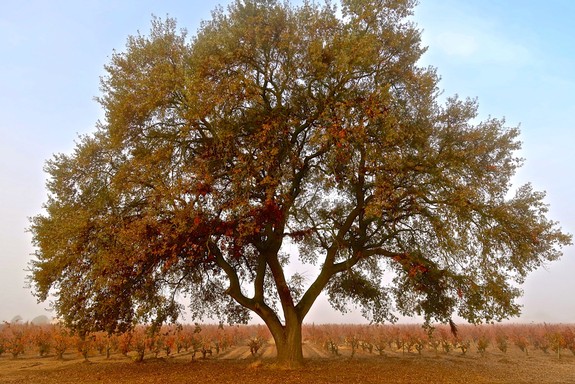
Indigenous valley oak and old vine Zinfandel on the west side of Lodi's Mokelumne River appellation.
The historic environment of valley oaks and grapes
Lodi's Mokelumne River AVA — an American Viticultural Area (i.e., AVA) established in 2006 by the TTB along with six other Lodi sub-appellations — is defined primarily by one common factor: It's deep (as much as 90 feet), porous yet high vigor soil, classified by the USDA as Tokay series fine sandy loam.
In the Soil Survey of The Lodi Area, California (Stanley W. Cosby and E.J. Carpenter), published by the USDA in 1937, there is a quote taken from the record of the John C. Frémont expedition of 1844. At that time, the area around the riverbanks of the Mokelumne River, where the City of Lodi would eventually pop up, was still unsettled by people of non-native or Spanish origin.
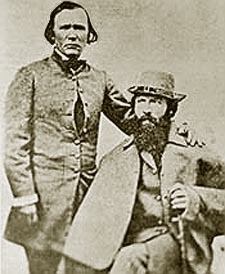
John C. Frémont (seated) with frequent expeditions guide Kit Carson (public domain).
Therefore, during Frémont's journey from Sutter's Fort (now Sacramento) southward, there is no mention of agricultural activity in the vicinity. According to the journal:
March 25. — We traveled for 28 miles over the same delightful country as yesterday, and halted in a beautiful bottom oat the ford of the Rio de Los Mukelmnes, receiving its name from another Indian tribe living on the river. The bottoms of the stream are broad, rich, and extremely fertile; and the uplands are shaded with oak groves. A showy Lupinus of extraordinary beauty, growing four to five feet in height, and covered with spikes in bloom, adorned the banks of the river, and filled the air with a light and grateful perfume.
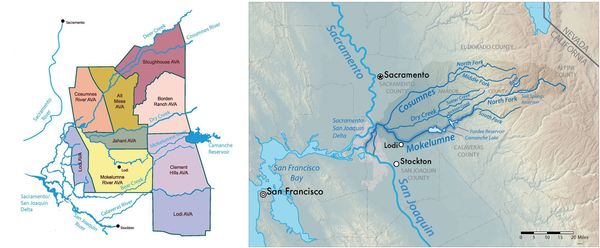
The Mokelumne River watershed aligned with the boundaries of Lodi's Mokelumne River AVA. AVA map courtesy of Society of Wine Educators.
Once a settlement, originally called Mokelumne (changed to Lodi in 1874), was established near the river's south banks in 1846, the very first planting in the area was 80 acres of wheat, followed quickly by more plantings of the same plus oats, barley, corn, potatoes, and land cleared for grazing livestock and horses.
The native oak is originally predominant in the "extremely fertile" area along the banks of the Mokelumne River is the valley oak (Quercus lobata). Of the approximately 500 extant species of oak trees, valley oaks are the largest. They require a generous water table well within the reach of their roots, and sufficiently deep and rich enough soils to grow to their typical heights (up to 60 feet within 20 years) and to reach their optimal longevity (up to 600 years).
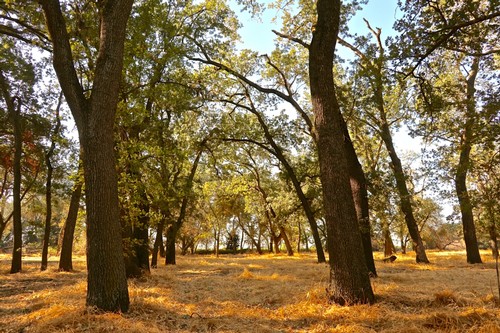
Part of the 32-acre valley oak grove on Jessie's Grove Winery's estate in mid-October.
In her book Jessie's Grove, Wanda Woock chronicled her great-grandfather Joseph Spenker's 1869 acquisition of over a thousand acres of untouched land just west of the Mokelumne and Woodbridge settlements. Writes Woock,
The land had hundreds of oak trees, and although it would work to clear some of them for planting, with the trees growing so abundantly, he knew the quality of the soil would be excellent. He later told how he had walked into the main grove and knew instantly it was his intended destination in California. He said the majestic trees towered over his head, reaching for the sky with strong limbs that were the color of damp earth.
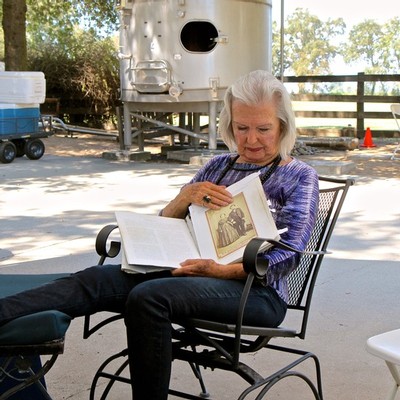
Wanda Woock displays photos of her great grandparents Joseph and Anna Spenker from a page of her book, Jessie's Grove.
To this day, the descendants of Joseph Spenker (Wanda Woock and her son, Jessie's Grove Winery owner/grower Greg Burns) have preserved the original 32 acres of valley oaks and native grassland set aside by Spenker. The grove is now named after Spenker's daughter, Jessie Beckmen (née Spenker), in tribute to her refusal to sell the property even during the 1930s, when the family was in severe financial straits due to failed investments following the Wall Street Crash of 1929, plus a crash of grape prices due to over-planting during Prohibition (which ended in 1933).
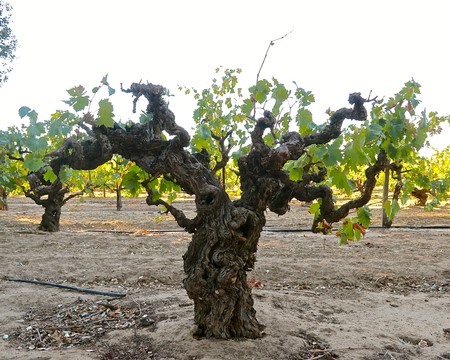
Zinfandel was planted in 1889 by Joseph Spencer, just south of his 32-acre valley oak grove.
Woock writes about the pressure put on Jessie during the 1930s after she took over the management of Speaker Ranch from her brother Otto:
People heard about the change in command and several people came to her with suggestions, and it always included the oak grove. "You could get more for that thirty-acre oak grove than two hundred acres of bare ground. Why don't you just sell the grove and retain the rest of the land?" Jessie's response was always the same: "My father protected that grove all the days of his life, and I will also protect it now. It was his prize possession, and likewise mine."
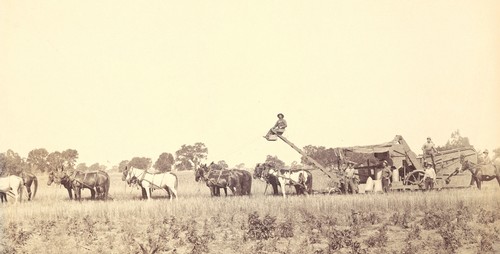
1890s photo of the wheat harvester in Lodi's Spenker Ranch, with the Spenker family's valley oak grove in the backdrop, and the family's first planting of grapes (now called Bechthold Vineyard, originally planted in 1886) in the foreground. Wanda Woock's Jessie's Grove.
By the 1930s, observed Cosby and Carpenter, Lodi agriculture was fairly diversified, including (in rough order of total acreage) wheat, wine and table grapes, beans, hops, grain hay, asparagus, alfalfa, sugar beets, corn, peaches, almonds, potatoes, prunes, and apples, plus even more land devoted to dairy and cattle pasturing. Regarding the burgeoning grape industry, given a recent push due to the demand for grapes during the Prohibition years (when Americans were compelled to make their own wine, at home), Cosby and Carpenter wrote:
Plantings of grapes are largely restricted to the central part of the valley plain, where the slightly elevated and better-drained sandy soils seem favorable to the production of heavy crops of high-quality grapes.
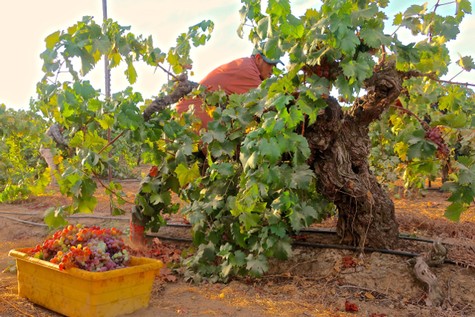
Flame Tokay harvest in Jessie's Grove's Royal Tee Vineyard, planted by Joseph Spenker in 1889.
Regarding the natural environment favorable to agriculture in the Lodi area, Cosby and Carpenter remarked:
The broad valley plain is now largely under cultivation, but it was probably formerly covered with scattered valley oaks and annuals. Somewhat denser stands of oaks apparently occupied many of the low ridges of deeper soils, and narrow belts of oak and cottonwood still mark the channels of the larger watercourses.
Not only is the Lodi area a locality of comparatively dense rural settlement, but it constitutes one of the more fertile and prosperous agricultural sections in this part of California. The climate of this area is of the Mediterranean type, characterized by hot, dry summers and cool, moist winters. Owing to its location opposite the wind gap leading inland from the Golden Gate, the range in temperature is narrower than in more northerly and southerly parts of the great [i.e., Central] Valley.
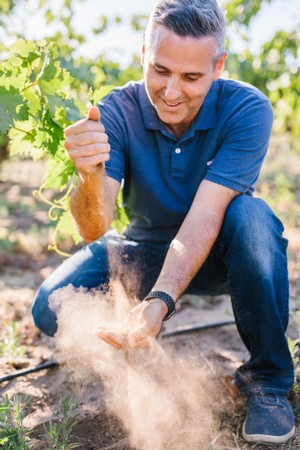
Lodi winegrower Jeff Perlegos demonstrates the fine sandy loam profile of Tokay series soil.
Tokay fine sandy loam's identification with Lodi's Mokelumne River AVA
When the broader Lodi AVA was approved by the ATF in 1986, at that time some 70% of the planted grape acreage in the AVA was concentrated in what would later become narrowed down as the Mokelumne River AVA, based primarily upon this appellation's deep, fine sandy loam soil and fairly flat, lower elevation (largely 25 to 95 feet) topography. Lodi's six other sub-appellation were identified by shallower soil types — primarily clay-based loams on terraces or slopes, with impervious hardpans as little as two feet deep.
The Mokelumne River AVA surrounds the City of Lodi on all sides and also encompasses the tiny unincorporated communities of Woodbridge, Victor, and Acampo. It consists of 85,700 total acres, of which the total number of planted vineyard acreage has continued to hover around 42,000 since the 1980s (currently, approximately 42% of the Lodi AVA's entire wine grape acreage).
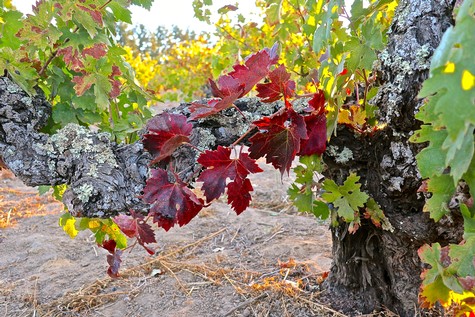
Gnarly armed ancient Zinfandel (planted 1903) in one of the sandiest pockets of Tokay series soil, just south of Victor on Lodi's east side.
When almost everyone — whether living in California or the U.S. or enjoying Lodi wines thousands of miles away in Asia, Europe, South America, or Russia — thinks of "Lodi," they think mostly of gnarly old vines and rich yet soft, fragrant Zinfandels. Over 98% of these vines and wines are grown in the Mokelumne River appellation.
When farmers talk about the Mokelumne River AVA, they are basically talking about all the parts of the Lodi region where you find Tokay series soil, since it's this specific soil type that defines the geographic boundaries of this appellation. Prior to 1990, the USDA classified this soil as Hanford series fine sandy loam. But this soil type, characterizing the alluvial plain surrounding the City of Lodi, was renamed because, as Lodi old-timers well know, this soil was closely associated with the Flame Tokay grape.
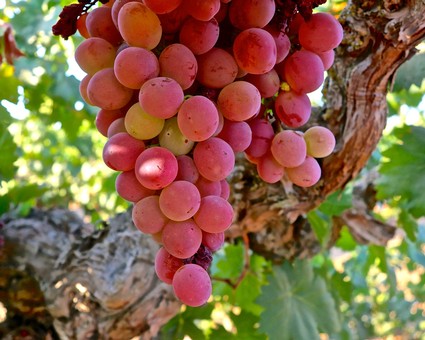
Flame Tokay, the fabled pink-skinned grape that lends its name to the Mokelumne River AVA's defining soil series.
Flame Tokay was a table grape (although it was also used for dessert wine and brandy production) that emerged as the area's most widely planted grape by the late 1880s. It remained the region's most widely planted grape, and one of the primary drivers of the local economy, for most of the following century.
Lodi farmers learned, very early on, that wherever you find this fine sandy loam — consisting of finely pulverized granite (the base rock of the Sierra Nevada range to the east) mixed with loam spread out by the "mighty" Mokelumne River over the flat plain east of the Delta over the past 25,000 years — you could get the Flame Tokay to attain its bright pink color, indicative of optimal ripeness and fruit quality. The Tokay fine sandy loam in Lodi occurs at depths as much as 50 to 90 feet deep, a profile also unique to Lodi when compared to other sandy loam soils found in wine regions elsewhere in California or around the world.
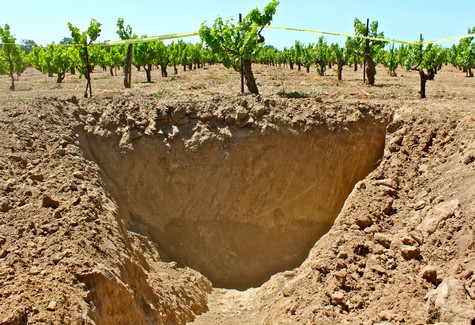
"Sandpit" recently dug alongside Lodi's Bechthold Vineyard (Cinsaut vines planted in 1886) demonstrating the consistency of fine sandy loam to depths of below 25 to 50 feet.
If they tried planting Flame Tokay in shallower soil such as in the Jahant AVA just north of the Mokelumne River AVA, or even on surrounding terraces with sufficient amounts of sandy topsoil and marked by the exact same climatic conditions, farmers quickly learned that the color and quality potential of the Flame Tokay for the fresh grape market was less than optimal. For Flame Tokay, correct soil is everything. The grape needed the vigor and depth of fine sandy loam peculiar to the Mokelumne River's alluvial plain. There was, in fact, Flame Tokay planted on more marginal sites, but these were usually the crops that ended up being crushed for the dessert wine and brandy industries rather than sold in the fresh grape market.
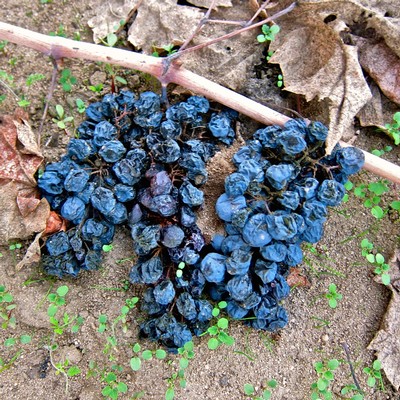
Close-up of discarded Zinfandel lying in fine-grained sandy loam soil in Lodi's Mokelumne River AVA.
During the same time frame as Flame Tokay's heyday, between the 1880s and 1980s, Lodi growers discovered another phenomenon that they could always bank on Wherever you can successfully plant Flame Tokay, you can also grow top-quality Zinfandel. Deep, fine sandy loam soil turned out to be just as ideal for this black-skinned wine grape, which became California's most widely planted wine grape by the late 1800s.
To this day, the majority of Lodi's vaunted "old vine" Zinfandel plantings, adding up to thousands of acres, are own-rooted (i.e. ungrafted) vines dating back to before the mid-1960s (the region's current oldest existing blocks were planted between 1889 and the 1920s). As it turned out, the other advantage of Tokay fine sandy loam soil is that it has never been hospitable to phylloxera, the root louse that forced the rest of the wine world (including almost all of California) to replant vineyards on phylloxera-resistant American rootstocks, starting in the 1870s.
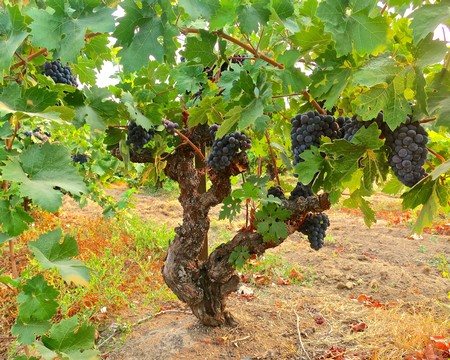
Own-rooted Zinfandel in Süss Vineyard, planted in a sandy loam pocket along the southern banks of the Mokelumne River in Lodi's Clements Hills AVA during the late 1920s, in response to the sudden demand for fresh grapes by home winemakers across the country during Prohibition.
As we remark in our previous post (see Burning questions about appreciating old vine wines), being own-rooted is not in itself a quality advantage, but it speaks to the soil factor accounting for the long-term health of Lodi's Zinfandel grape industry, and why the region has remained easily the most productive source of the variety (about 42% of California's annual crush) in the state.
When, in 1907, the City of Lodi held its first and only wham-bam, a three-day grape festival called the Tokay Carnival, the proceedings were overseen by a publicly elected "Queen Zinfandel" and "King Tokay" (see In 1907 Lodi celebrated grapes as no American city never-ever has). By the same token, the Mokelumne River appellation's soil series may have just as well have been renamed "Zinfandel series fine sandy loam," since it's Zinfandel that has remained Lodi's most widely planted grape, whereas Flame Tokay has gone the way (like watermelons) of other seeded fruit products.
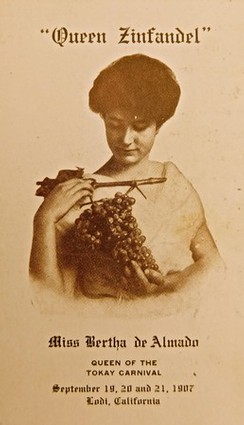
Flame Tokay, however, was historically a phenomenon peculiar to Lodi — in no other region of the world did it find such a natural environment. The pink-colored grape may no longer rule the region's grape industry. But it has given its unusual name to the soils that define the Mokelumne River appellation, the profile of which will always remain totally unique in the entire world of wine.
To be continued in Tokay series fine sandy loam, part 2 — sandy loam vs. loamy sand
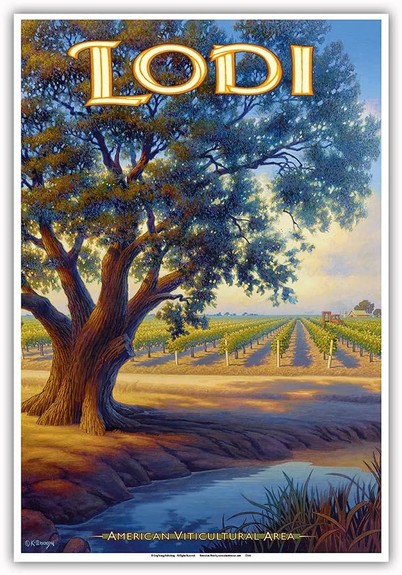
Artistic rendering of Lodi, depicting its lush environment as suitable to towering oaks as it is to grapes. Image courtesy of Kerne Erickson.